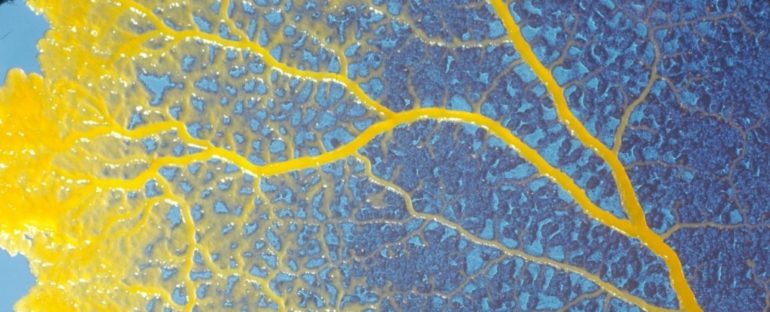It may be a single-celled organism, but the slime mould Physarum polycephalum has some pretty fascinating tricks up its pretty yellow sleeves. Now new research has found that it seems to “remember” where it previously found sources of food – even without a brain or nervous system.
This could help explain how network organisms can not just live, but thrive, in complex environments, the researchers said – and could also be a key to understanding the mechanisms of memory formation in such species.
P. polycephalum is one of the most peculiar forms of life on Earth. It is neither plant, animal, or fungus, but a species of complex, single-celled amoeba of the protist kingdom (sort of the catch-all group for anything that can’t be neatly categorized in the other three kingdoms).
Early in its life cycle, P. polycephalum exists as a single cell with a single nucleus, but later it merges with other cells to form a huge single cell with millions of nuclei inside.
This is the plasmodium stage, and the organism can grow to cover an area up to several square meters. Its body consists of a complex network of interconnected tubes, the squeezing of which creates flow between different regions. This network can rapidly grow and reorganize itself to maximize its use of its environment.
A Physarum plasmodium. (Carolina Biological Supply Company/Flickr/CC BY-NC-ND 2.0)
In 2000, Japanese researcher Toshiyuki Nakagaki of RIKEN discovered that P. polycephalum was capable of solving a simple maze to reach a food source. Since then, scientists have discovered several intelligent-like behaviors, like being able to efficiently solve the Traveling Salesman Problem, and ‘remembering’ substances.
In its latest trick, biological physicists Mirna Kramar and Karen Alim of the Max Planck Institute for Dynamics and Self-Organization in Germany have discovered, P. polycephalum uses the very architecture of its body to store memories about where it has previously found food.
“We followed the migration and feeding process of the organism and observed a distinct imprint of a food source on the pattern of thicker and thinner tubes of the network long after feeding,” Alim explained.
“Given P. polycephalum’s highly dynamic network reorganization, the persistence of this imprint sparked the idea that the network architecture itself could serve as memory of the past. However, we first needed to explain the mechanism behind the imprint formation.”
Using microscopic observations, they made a careful study of how the organism arranged itself around a food source. They then used theoretical modeling to understand what was going on inside the slime mould during that process.
They concluded that the discovery of a source of food triggers the release of a chemical that locally softens the tube wall at the site of the food. This then triggers the tubes to dilate, becoming wider, to expedite flow within the slime mould to the site.
The chemical also signals to the entire organism where the food can be found, so that it can move towards the site and focus on feeding.
P. polycephalum can reabsorb parts of its body if it stretches out exploratory tubes into a region that is inhospitable, or contains nothing of interest. But when it has found and eaten a nutritious meal, those thick tubes remain in place so that it can quickly return to the site if food were to reappear, the researchers found.
“The gradual softening is where the existing imprints of previous food sources come into play and where information is stored and retrieved,” Kramar said.
“Past feeding events are embedded in the hierarchy of tube diameters, specifically in the arrangement of thick and thin tubes in the network. For the softening chemical that is now transported, the thick tubes in the network act as highways in traffic networks, enabling quick transport across the whole organism. Previous encounters imprinted in the network architecture weigh into the decision about the future direction of migration.”
This is not utterly dissimilar to how the human brain works. One must be cautious drawing parallels between slime mould and the human brain, but there are some interesting similarities that might be able to help us understand how information encoding works in various types of organisms.
In this case, synapses, which send information between neurons, strengthen when we learn and grow stronger the more we use them, but can grow weaker if we don’t – vaguely similar to the slime mould’s tubes, which will grow thicker at sites of interest, but will die off or be reabsorbed if their presence is no longer useful to the organism.
“It is remarkable that the organism relies on such a simple mechanism and yet controls it in such a fine-tuned way,” Alim said.
“These results present an important piece of the puzzle in understanding the behavior of this ancient organism and at the same time point to universal principles underlying behavior. We envision potential applications of our findings in designing smart materials and building soft robots that navigate through complex environments.”
The research has been published in PNAS.



